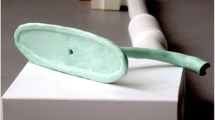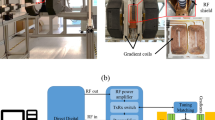Abstract
MRI imaging with long acquisition times is prone to motion artifacts that can compromise image quality and lead to misinterpretation.
Aiming to address this challenge at the sub-millimeter level, we developed and evaluated a maxilla immobilization approach, which is known to have better performance than other non-invasive techniques, using a personalized mouthpiece connected to an external MRI-compatible frame.
The effectiveness of the device was evaluated by analyzing MRI imagery obtained in different immobilization conditions on a human volunteer. The SURF and Block Matching algorithms were assessed, supplemented by custom software.
Compared with simple cushioning, the immobilizer reduced the amplitudes of involuntary slow-drift movements of the head by more than a factor two in the axial plane, with final values of 0.25 mm and 0.060°. Faster involuntary motions, including those caused by breathing (which were identifiable), were also suppressed, with final standard deviation values below 0.045 mm and 0.025°.
It was also observed a strong restriction of intentional movements, translationally and angularly, by factors from 7.8 to 4.6, with final values of 0.5 mm and 0.2° for moderate forcing.
Access this chapter
Tax calculation will be finalised at checkout
Purchases are for personal use only
Similar content being viewed by others
References
Babic, S., et al.: To frame or not to frame? Cone-beam CT-based analysis of head immobilization devices specific to linac-based stereotactic radiosurgery and radiotherapy. J. Appl. Clin. Med. Phys. 19(2), 111–120 (2018)
Ramakrishna, N., et al.: A clinical comparison of patient setup and intra-fraction motion using frame-based radiosurgery versus a frameless image-guided radiosurgery system for intracranial lesions. Radiother. Oncol. 95(1), 109–115 (2010)
Mandija, S., et al.: Brain and head-and-neck MRI in immobilization mask: a practical solution for MR-only radiotherapy. Front. Oncol. 9(1), 647 (2019)
Li, G., et al.: Motion monitoring for cranial frameless stereotactic radiosurgery using video-based three-dimensional optical surface imaging. Med. Phys. 38(7), 3981–3994 (2011)
Waplera, M.C., et al.: Magnetic properties of materials for MR engineering, micro-MR and beyond. J. Magn. Reson. 242(1), 3981 (2014)
The MathWorks, Inc. MATLAB version: 9.11.0 (R2021b) (2021). https://www.mathworks.com. Accessed 01 Sept 2022
Tekalp, A.M.: Digital Video Processing. Prentice Hall PTR, Upper Saddle River (1995)
Barjatya, A.: Block Matching Algorithms For Motion Estimation (2004)
Di Stefano, L., Viarani, E.: Vehicle detection and tracking using the block matching algorithm (1999)
Bay, H., et al.: SURF: speeded up robust features. Comput. Vis. Image Underst. 110(3), 346–359 (2008)
Flenady, T., Dwyer, T., Applegarth, J.: Accurate respiratory rates count: so should you! Aust. Emerg. Nurs. J. 20(1), 45–47 (2017)
Author information
Authors and Affiliations
Corresponding author
Editor information
Editors and Affiliations
Rights and permissions
Copyright information
© 2024 Springer Nature Switzerland AG
About this paper
Cite this paper
Zagalo, F. et al. (2024). Development and Testing of an MRI-Compatible Immobilization Device for Head and Neck Imaging. In: Vasconcelos, V., Domingues, I., Paredes, S. (eds) Progress in Pattern Recognition, Image Analysis, Computer Vision, and Applications. CIARP 2023. Lecture Notes in Computer Science, vol 14469. Springer, Cham. https://doi.org/10.1007/978-3-031-49018-7_44
Download citation
DOI: https://doi.org/10.1007/978-3-031-49018-7_44
Published:
Publisher Name: Springer, Cham
Print ISBN: 978-3-031-49017-0
Online ISBN: 978-3-031-49018-7
eBook Packages: Computer ScienceComputer Science (R0)





